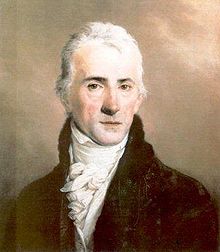Ferenc Kazinczy
Franz and Ferenc Kazinczy von Kazincz and Alsóregmecz (born October 27, 1759 in Érsemjén , † August 23, 1831 in Széphalom ) was a Hungarian writer and reformer of Hungarian literature and language who was influenced by the ideas of the Enlightenment .
Life
Kazinczy studied in Kaschau (today's Košice, Hungarian: Kassa) and Eperjes , or in Pest , where he acquired extensive knowledge in the fields of French and German literature . He met Gedeon Ráday (1713–1792), who allowed him to visit his library regularly.
In 1784 Kazinczy became a notary of Abaúj-Torna County . In the same year he was accepted as a Freemason in the Lodge of the Virtuous Cosmopolitan in Miskolc . There he used the artist name Orpheus , which he also used as the title for a magazine published in Kassa in 1790.
1786–1791 he was inspector of the national schools in the Kaschau district. During his tenure, he decided to reform the Hungarian language and literature by translating the classics and expanding the language's vocabulary.
In 1788 he started the first Hungarian literary magazine with the title Magyar Múzeum with his friends David Baróti Szabó (1739-1819) and János Batsányi . Kazinczy had to leave his office under Emperor Leopold II because he was not a Catholic . Nevertheless he continued with his literary work. He helped Ráday found and run the first Hungarian Dramatic Society and made numerous other translations into Hungarian. His Hamlet translation was premiered in Kassa in 1790.
In December 1794, Kazinczy was accused of being involved in the Martinovics ' conspiracy . He was sentenced to death, but the sentence was commuted to imprisonment.
In 1801 Kazinczy was acquitted, after which he married Sophie Török , the daughter of his former sponsor. He retired to a small house in Széphalom, near Sátoraljaújhely (north-east Hungary).
In 1828 he took part in a series of conferences on the establishment of the Hungarian Academy of Sciences . He became their first corresponding member.
Kazinczy died of cholera in Széphalom in 1831 .
In 1873 a monument to Kazinczy designed by Miklós Ybl was inaugurated in Széphalom .
Works
Kazinczy was an important figure in the Hungarian language reform movement. The result of this movement were thousands of new words that brought the Hungarian language up to date with the scientific developments of the time. As a result, Hungarian was recognized as the official language of Hungary in 1844 .
Kazinczy translated works by:
- Gotthold Ephraim Lessing
- Johann Wolfgang von Goethe
- Christoph Martin Wieland
- Klopstock
- Ossian
- La Rochefoucauld
- Marmontel
- Molière
- Metastasis
- William Shakespeare
- Laurence Stars
- Cicero
- Sallust
- Anacreon
He was involved in the processing of various works, including:
- Baróczy (Pest, 1812, 8 volumes)
- Miklós Zrínyi (1817, 2 volumes)
- Dayka (1813, 3 volumes)
- John Kis (1815, 3 volumes)
1814-1816 a collection of his works in nine volumes was published in Pest. There were also five volumes of letters. In 1858 and 1863 a collection of his poems was published.
swell
- ↑ Eugen Lennhoff, Oskar Posner, Dieter A. Binder: Internationales Freemaurer Lexikon . Herbig Verlag, 5th edition, ISBN 978-3-7766-2478-6
- Encyclopædia Britannica , Eleventh Edition.
literature
- Constantin von Wurzbach : Kazinczy, Franz . In: Biographisches Lexikon des Kaiserthums Oesterreich . 11th part. Kaiserlich-Königliche Hof- und Staatsdruckerei, Vienna 1864, pp. 97–110 ( digitized version ).
- Kazinczy, Ferenc from. In: Austrian Biographical Lexicon 1815–1950 (ÖBL). Volume 3, Verlag der Österreichischen Akademie der Wissenschaften, Vienna 1965, p. 278.
- Fiction
- Gergely Péterfy : The stuffed barbarian. Novel. György Buda in Romanian. Nischen Verlag, Vienna 2016. ISBN 978-3-9503906-2-9 .
Web links
- Literature by and about Ferenc Kazinczy in the catalog of the German National Library
- Ferenc Kazinczy and German literature (PDF) (52 kB)
| personal data | |
|---|---|
| SURNAME | Kazinczy, Ferenc |
| ALTERNATIVE NAMES | Kazinczy von Kazincz and Alsóregmecz, Ferenc (full name) |
| BRIEF DESCRIPTION | Hungarian writer and language reformer |
| DATE OF BIRTH | October 27, 1759 |
| PLACE OF BIRTH | Érsemjén |
| DATE OF DEATH | August 23, 1831 |
| Place of death | Széphalom |

